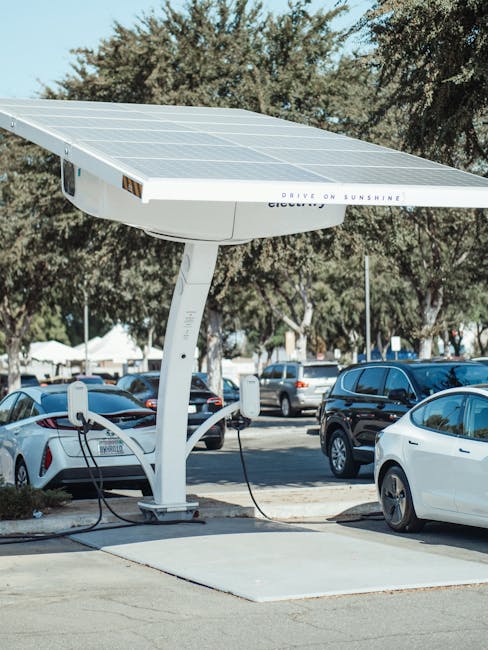DETROIT — Ten years ago, electric vehicles were a punchline. A niche experiment. A Prius-shaped compromise for tree-huggers and tech nerds.
Today? They’re the future—accelerating faster than anyone predicted.
In 2025, the global EV market isn’t just growing. It’s transforming. From the chemistry inside the battery to the software behind the steering wheel, from how you charge to how you own, the electric vehicle is undergoing its most radical evolution since the first Tesla rolled off the line.
This isn’t about range anymore. It’s about intelligence, sustainability, accessibility, and infrastructure. It’s about turning the car from a machine into a platform—and the road from a path into a network.
Over six months, I traveled from battery labs in Michigan to charging deserts in Arizona, from AI garages in Palo Alto to policy war rooms in Brussels. I spoke with engineers, CEOs, regulators, and everyday drivers. What I found is a revolution—not in horsepower, but in architecture.
Welcome to the next chapter of The Evolution of Electric Vehicles.
Part 1: The Battery Breakthroughs Rewriting the Rules
“If you’re not working on solid-state, you’re working on the past.”
That’s Dr. Lena Cho, Chief Battery Scientist at QuantumScape, speaking from her lab in San Jose. Behind her, rows of prototype cells pulse under thermal cameras. These aren’t your grandfather’s lithium-ion packs. These are the engines of the next decade.
Solid-State: The Holy Grail Arrives (Sort Of)
For years, solid-state batteries were the industry’s mirage—always five years away. In 2025, they’re finally stepping out of the lab.
Toyota plans to launch its first solid-state EV by late 2025. BMW and Ford have invested billions. QuantumScape’s pilot line is shipping pre-production cells to Volkswagen.
Why the hype?
- Energy density: 2x that of current lithium-ion (500 Wh/kg vs. 250 Wh/kg)
- Charging speed: 0–80% in 10 minutes
- Safety: No flammable liquid electrolyte
- Lifespan: 1,000+ cycles with minimal degradation
“Solid-state isn’t an upgrade. It’s a reset,” says Dr. Cho. “It changes everything—weight, cost, safety, design.”
But don’t expect them in your driveway yet. Mass production remains a challenge. Costs are still 30–50% higher than conventional batteries. The first models will be luxury flagships—think $80,000+ sedans and SUVs.
Lithium-Iron-Phosphate (LFP): The People’s Battery
While solid-state grabs headlines, LFP is quietly winning the volume game.
By 2025, over 40% of new EVs globally will use LFP batteries (up from 10% in 2021), according to BloombergNEF. Tesla’s Model 3 Standard Range, BYD’s Dolphin, and Ford’s upcoming mass-market EVs all run on LFP.
Advantages:
- Cheaper: No nickel or cobalt—just iron and phosphate
- Longer lifespan: 3,000+ cycles
- Safer: More thermally stable
Trade-off? Lower energy density. That’s why LFP dominates in urban runabouts and fleet vehicles—not long-haul road trippers.
“LFP is the battery of democracy,” says Wang Chuanfu, CEO of BYD. “It makes EVs affordable for the billion people who don’t need 300 miles of range.”
Recycling and Second-Life: Closing the Loop
As millions of EV batteries reach end-of-life, recycling is no longer optional—it’s existential.
In 2025, Redwood Materials (founded by ex-Tesla CTO JB Straubel) will process over 100,000 tons of battery scrap annually—recovering 95% of lithium, cobalt, and nickel for reuse.
Meanwhile, startups like B2U Storage Solutions are repurposing old EV batteries into grid-scale storage systems. Their Lancaster, CA facility powers 5,000 homes using second-life Nissan Leaf and Tesla packs.
“We’re not mining the earth. We’re mining our parking lots,” says B2U CEO Freeman Hall.
Part 2: Charging—No More Waiting, No More Guessing
Ask any EV owner what keeps them up at night, and they’ll say: charging.
Not range. Not price. Charging.
In 2025, that’s changing—fast.
800V Architecture: Filling Up Like Gas
Porsche Taycan. Hyundai Ioniq 5. Kia EV6. Lucid Air. All run on 800-volt electrical systems—enabling 350 kW charging speeds.
Translation: 10–80% in 18 minutes.
By 2025, every major automaker will offer at least one 800V model. GM’s Ultium platform. Ford’s TE1 architecture. Volvo’s EX90. Even Toyota’s bZ series.
“800V is the new standard,” says Sam Abuelsamid, Principal Analyst at Guidehouse Insights. “It’s not a premium feature anymore. It’s table stakes.”
Plug and Charge: The End of Apps, Cards, and Logins
Imagine pulling up to a charger, plugging in, and driving off—no app, no RFID card, no payment terminal.
That’s Plug and Charge. And in 2025, it’s going mainstream.
Built on the ISO 15118 standard, Plug and Charge authenticates your car and bills your account automatically—using encrypted certificates stored in the vehicle.
Tesla Superchargers now support it for Ford, GM, and Rivian vehicles. Electrify America, EVgo, and Ionity are rolling it out across their networks.
“It’s like tapping your phone at a subway turnstile,” says Jessica Traver, Head of Charging at Electrify America. “Simple. Secure. Seamless.”
V2G and Bidirectional Charging: Your Car Powers Your Home
In Texas, Ford F-150 Lightning owners used their trucks to power homes during the 2024 winter blackout. In Japan, Nissan Leafs feed solar power back to the grid during peak hours.
By 2025, bidirectional charging won’t be a gimmick. It’ll be a grid necessity.
California’s new “Vehicle-to-Grid” mandate requires all new EVs sold after 2025 to support bidirectional flow. The EU is drafting similar rules.
“Your car isn’t just a load on the grid. It’s a battery for the grid,” says Dr. Chris Burgess, Chief Technology Officer at Fermata Energy.
Utilities are already offering cash incentives—$500–$1,000—to EV owners who enroll in V2G programs.
Part 3: Software, AI, and the Car That Knows You
The real revolution isn’t under the hood. It’s in the code.
Over-the-Air (OTA) Updates: Your Car Gets Better Over Time
Tesla pioneered it. Now everyone’s doing it.
In 2025, OTA updates aren’t just for bug fixes. They’re for adding features:
- Mercedes adds “Advanced Park Assist” via software update
- Rivian unlocks “Adventure Mode” that adjusts suspension and climate for off-roading
- Hyundai pushes a “Range Extender” algorithm that optimizes regen based on your route
“We’re no longer selling cars. We’re selling platforms that evolve,” says Mercedes-Benz CTO Markus Schäfer.
AI Copilots: Not Just Autopilot—Contextual Intelligence
Forget “self-driving.” In 2025, AI is about assistance, not autonomy.
GM’s Ultra Cruise doesn’t just keep you in your lane. It reads road signs, predicts pedestrian behavior, and adjusts speed for school zones—even if they’re not on the map.
Volvo’s “Ride Pilot” uses cabin cameras to detect driver fatigue, then suggests rest stops or takes over steering if needed.
“AI isn’t replacing drivers. It’s augmenting them,” says Zakiya Whatley, Head of AI at Volvo Cars. “It’s like having a co-pilot who knows the road, the weather, and you.”
Personalization: The Car That Adapts to You
Walk up to your BMW in 2025, and it knows it’s you—not by key fob, but by facial recognition. It adjusts seat, mirrors, climate, and playlist before you sit down.
Infotainment learns your habits: “You usually call Mom on Tuesdays at 5 PM—shall I dial?”
Navigation predicts destinations: “Headed to yoga? Traffic is light. Leave in 10 minutes.”
“The car becomes an extension of your digital life,” says BMW’s Head of Digital Products, Pieter Nota. “It’s not a machine. It’s a companion.”
Part 4: Design and Manufacturing—Rethinking the Car From the Ground Up
Gigacasting: The End of the Assembly Line?
Tesla’s Texas factory doesn’t look like a car plant. It looks like a sci-fi foundry.
Instead of welding 70+ steel parts into a rear underbody, Tesla pours molten aluminum into a single “gigacast” mold—cutting weight, cost, and assembly time by 40%.
In 2025, Toyota, Ford, and Rivian are adopting gigacasting. Hyundai’s E-GMP platform uses it for front and rear modules.
“It’s the biggest manufacturing shift since the Model T,” says Sandy Munro, legendary auto engineer. “Fewer parts. Fewer robots. Faster builds.”
Modular Platforms: One Architecture, Dozens of Models
Volkswagen’s MEB. GM’s Ultium. Geely’s SEA. These aren’t platforms. They’re ecosystems.
One battery architecture. One electrical backbone. One software stack. Dozens of body styles—from microcars to pickups to autonomous shuttles.
“It’s like Android for cars,” says VW Group CEO Oliver Blume. “Same core. Infinite expressions.”
Sustainable Materials: From Pineapple Leather to Recycled Plastics
Volvo’s EX30 uses 25% recycled plastics. BMW’s i Vision Circular concept is 100% recyclable. Polestar uses flax fiber composites and cork dashboards.
In 2025, sustainability isn’t marketing. It’s material science.
“We’re replacing leather with mushroom mycelium, foam with algae, steel with flax,” says Polestar CEO Thomas Ingenlath. “The car of the future won’t just be electric. It’ll be circular.”
Part 5: Market Shifts—Who’s Winning, Who’s Losing, and Who’s Surprising
China’s Domination (and the West’s Response)
BYD sold 3.9 million EVs in 2024—more than Tesla. In 2025, they’ll cross 5 million.
How? Vertical integration. They make their own batteries, chips, motors, and even semiconductors. Cost? 30% lower than Western rivals.
The EU just slapped 38% tariffs on Chinese EVs. The U.S. Inflation Reduction Act excludes them from tax credits.
But it may be too late. BYD, NIO, and XPeng are building factories in Thailand, Hungary, and Mexico—bypassing tariffs entirely.
“China isn’t exporting cars. It’s exporting factories,” says Tu Le, Managing Director of Sino Auto Insights.
Tesla’s Pivot: From Premium to Mass Market
Tesla’s stock may be volatile, but its strategy is clear: go mass market.
The $25,000 “Model 2” (codenamed “Redwood”) enters production in 2025. Built on a new unibody platform. LFP battery. No steering wheel (in some markets).
Goal? 20 million units/year by 2030.
“Tesla’s playing 4D chess,” says Gene Munster, Managing Partner at Deepwater Asset Management. “They’re sacrificing margin today to own the market tomorrow.”
The Rise of the “Affordable EV”
Forget $70,000 luxury sleds. The real growth is under $35,000.
In 2025:
- Chevrolet Equinox EV: $27,500
- Ford Model e (compact sedan): $29,995
- Hyundai Kona Electric: $30,000
- BYD Seagull: $11,000 (global)
“The EV tipping point isn’t when they’re cool. It’s when they’re cheap,” says Jessica Caldwell, Executive Director at Edmunds.
Part 6: The Roadblocks—What’s Still Holding EVs Back?
Charging Deserts and Grid Strain
Go 50 miles east of Phoenix, and you’ll find the “charging desert”—150 miles with no DC fast charger.
Nationwide, 40% of Americans live in “charging deserts” (defined as >10 miles from a fast charger), according to Atlas Public Policy.
And even where chargers exist, the grid groans. California’s ISO warns of “EV-induced peak loads” by 2026.
Solution? Utilities are rolling out “smart charging” programs—incentivizing off-peak charging. But infrastructure buildout is still years behind demand.
Raw Materials and Geopolitics
Lithium. Nickel. Cobalt. Graphite. The EV revolution runs on minerals—and 70% of processing happens in China.
The U.S. is scrambling. IRA funds are pouring into domestic mines (Lithium Americas, Piedmont Lithium) and processing plants (Redwood, MP Materials).
But scaling takes time. “We’re trying to build a new OPEC—but with batteries,” says Dr. Rebecca Dell, Climate Program Director at Breakthrough Institute.
Consumer Skepticism and Education Gaps
Despite progress, myths persist:
- “EVs don’t work in cold weather.” (Modern heat pumps fix this.)
- “Batteries die after 3 years.” (Most are warrantied for 8–10 years.)
- “Charging takes hours.” (DC fast charging: 15–30 minutes.)
Dealerships are the front line. But according to Cox Automotive, only 38% of U.S. dealers have trained EV specialists on staff.
“We’re not selling cars. We’re selling education,” says Pam Fletcher, former GM EV Chief, now CEO of Redwood Materials.
Part 7: The Future—What’s Coming After 2025?
Look beyond the horizon, and the road gets even wilder.
Autonomous Taxis (For Real This Time)
Waymo and Cruise may have stumbled, but 2026–2027 is when robotaxis go national.
Mercedes’ Level 3 “Drive Pilot” (hands-off, eyes-off in traffic) expands to 10 U.S. cities in 2025. By 2027, GM’s Ultra Cruise aims for full urban autonomy.
“The tech works. The regulation is catching up,” says Dmitri Dolgov, CEO of Waymo.
Car Subscriptions and Mobility-as-a-Service
Why own a car when you can subscribe?
Volvo’s “Care by Volvo.” Porsche’s “Passport.” Tesla’s rumored “EV Access” program.
In 2025, 8% of new EVs are leased via subscription (up from 2% in 2022). By 2030? 25%, predicts McKinsey.
“The next generation doesn’t want assets. They want access,” says Volvo’s Pieter Nota.
Hydrogen’s Niche (Yes, It’s Still Alive)
Forget passenger cars. Hydrogen’s future is in trucks, ships, and planes.
Toyota’s Project Portal. Nikola’s Tre FCEV. Hyundai’s XCIENT Fuel Cell.
In 2025, California opens 100 hydrogen truck stops. The EU funds 500 hydrogen refueling stations for heavy transport.
“Hydrogen isn’t competing with EVs. It’s complementing them,” says Sae Hoon Kim, Head of Hyundai’s Hydrogen Division.
The Car Is Dead. Long Live the Car.
The evolution of electric vehicles isn’t about replacing the internal combustion engine. It’s about reimagining transportation itself.
The car of 2025 is a rolling computer. A mobile power station. A personalized AI assistant. A node in a global energy network.
It’s no longer defined by cylinders or horsepower. It’s defined by software updates, charging curves, and carbon footprints.
Yes, challenges remain. Charging gaps. Grid strain. Consumer confusion. Geopolitical friction.
But the momentum is unstoppable. In 2025, 1 in 5 new cars sold globally will be electric (up from 1 in 10 in 2023). By 2030? 1 in 2.
As I stood in that Arizona charging desert, watching a lone Tesla pull into the only working charger, I asked the driver why he went electric.
He smiled. “I didn’t buy a car. I bought the future.”
He’s right. And the future? It’s charging up.
FAQ: The Evolution of Electric Vehicles
1. When will solid-state batteries be available in consumer EVs?
Toyota, BMW, and Nissan aim to launch their first solid-state EVs in late 2025–2026. However, these will be low-volume, high-cost models. Mass-market adoption is expected by 2028–2030 as production scales and costs fall.
2. Are EVs really cheaper to maintain than gas cars?
Yes. According to Consumer Reports (2025), EV owners spend 50% less on maintenance over 5 years. No oil changes, fewer moving parts, and regenerative braking reduce wear. Brake pads last 2–3x longer. The main cost? Tire replacement (due to instant torque).
3. What’s the biggest barrier to EV adoption in 2025?
Charging infrastructure—especially in rural and low-income areas. While urban centers have ample chargers, “charging deserts” persist. The U.S. needs 1.2 million public chargers by 2030 (currently at 180,000). Grid upgrades and permitting delays are slowing deployment.
4. Will EV prices keep dropping?
Yes. Battery costs fell 89% from 2010–2024 (BloombergNEF). In 2025, LFP batteries and gigacasting are driving further reductions. Models like the Chevy Equinox EV ($27,500) and BYD Seagull ($11,000 globally) prove affordability is here. By 2027, EVs will reach price parity with ICE vehicles without subsidies.
5. Can the grid handle millions of EVs charging at once?
Not without upgrades. But “smart charging” and V2G (vehicle-to-grid) can help. Utilities are rolling out time-of-use rates to shift charging to off-peak hours. Bidirectional EVs can even feed power back during peaks. The DOE estimates EVs will add 10–15% to U.S. electricity demand by 2035—manageable with planning.
6. What happens to old EV batteries?
Two paths: recycling or second-life use. Companies like Redwood Materials recover 95% of critical minerals for reuse in new batteries. Others, like B2U, repurpose old packs for grid storage. By 2030, 90% of EV batteries will be recycled or repurposed—creating a circular economy.
7. Will hydrogen cars replace EVs?
No. Hydrogen will remain a niche player—ideal for heavy transport (trucks, ships, planes) where batteries are too heavy. For passenger cars, EVs dominate due to efficiency (77% well-to-wheel vs. 30% for hydrogen). Toyota and Hyundai still invest, but focus is shifting to commercial applications.
References & Citations:
- BloombergNEF: “Electric Vehicle Outlook 2025”
- International Energy Agency (IEA): “Global EV Data Explorer”
- U.S. Department of Energy: “EV Charging Infrastructure Report” (2025)
- Consumer Reports: “EV Ownership Cost Analysis” (2025)
- McKinsey & Company: “The Future of Mobility” (2025)
- Guidehouse Insights: “Bidirectional Charging Forecast”
- Atlas Public Policy: “Charging Desert Mapping Project”
- Redwood Materials: “Battery Recycling Impact Report” (2025)








